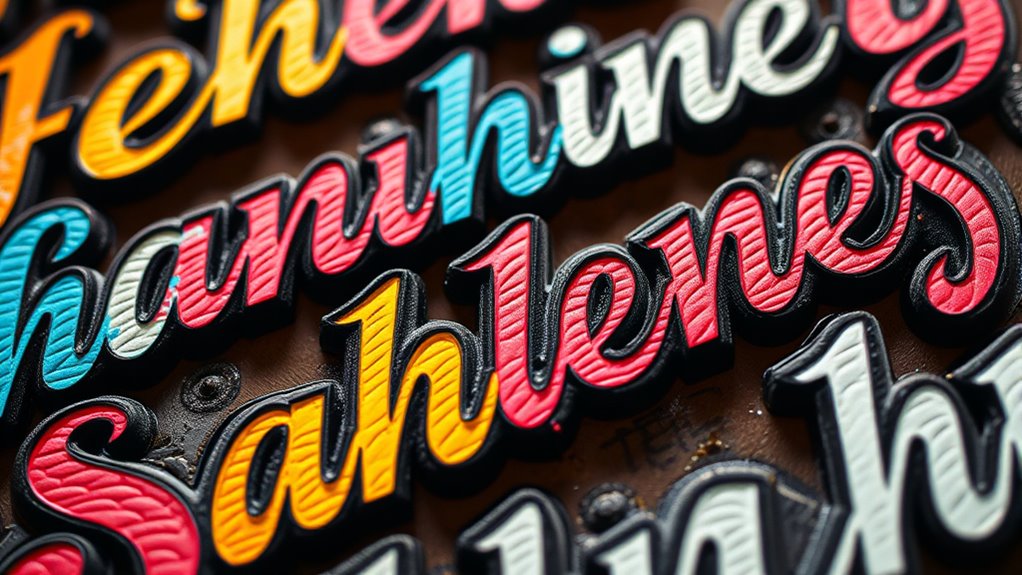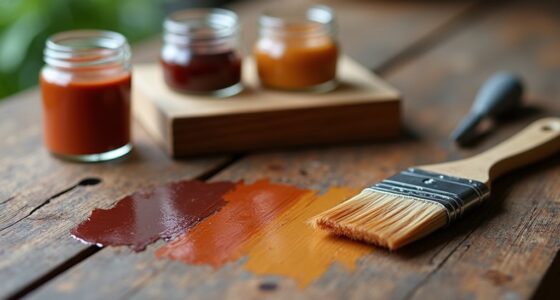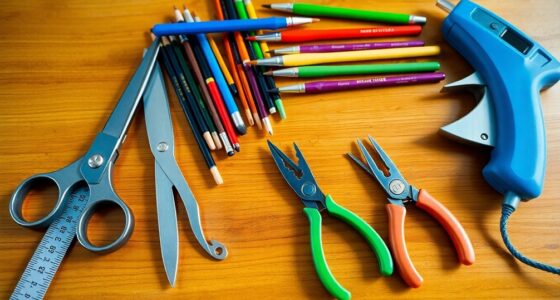To create stunning hand-lettered signs, you’ll need a variety of tools like brush pens, markers, nibs, and inks suited for your chosen surface, whether wood, chalkboard, or acrylic. Techniques include sketching rough outlines, practicing strokes for consistent letterforms, and layering colors for depth. Mastering pressure control and brush angles helps achieve the desired style. With practice, you’ll develop your signature look—keep exploring these tools and techniques to elevate your craftsmanship. If you’re enthusiastic to improve further, you’ll find plenty of tips ahead.
Key Takeaways
- Use brushes, pens, and markers tailored to your chosen lettering style for precise control.
- Select appropriate surfaces like wood, chalkboard, or metal based on your design goals.
- Employ techniques such as sketching, tracing, and layering to achieve consistency and detail.
- Incorporate tools like rulers, stencils, and masking tape for alignment and clean edges.
- Choose high-quality paints or inks suited for your material to ensure durability and vibrant results.

Have you ever noticed how hand-lettered signs can instantly catch your eye? It’s because of the unique charm and personality that skilled lettering brings to a sign. When you see a hand-lettered sign, you’re not just reading words—you’re experiencing a piece of art. The key to creating eye-catching signs lies in understanding the different lettering styles and choosing the right sign materials. These elements work together to make your message stand out and resonate with your audience.
Lettering styles are the foundation of any good hand-lettered sign. From bold, blocky fonts to delicate, script-like flourishes, each style conveys a different mood and tone. For instance, a vintage-style sign might feature ornate, decorative lettering that evokes nostalgia, while a modern, minimalist sign could use clean lines and simple sans-serif fonts for clarity. Your choice of lettering style depends on the message you want to communicate and the atmosphere you wish to create. Experimenting with various styles can help you develop a signature look that aligns with your brand or personal aesthetic. Remember, the style you select should be legible and appropriate for the context, whether it’s a storefront, event signage, or a decorative piece. Understanding market trends can also help you select styles that are currently popular and appealing.
Sign materials also play a pivotal role in the success of your hand-lettered signs. Different materials, such as wood, metal, acrylic, or chalkboard surfaces, can dramatically change the appearance and durability of your work. For example, wood provides a rustic, warm background that complements hand-painted lettering, making it perfect for boutique shops or cafes. Metal signs offer a sleek, durable surface ideal for outdoor settings, while chalkboards give you the flexibility to change messages frequently, adding a casual, approachable vibe. The choice of material influences not only the aesthetic but also the tools and techniques you’ll use. Some surfaces may require specific paints, brushes, or markers to achieve the best results. Additionally, the material’s texture and color can enhance or challenge your lettering style, so selecting the right sign material is essential to bring your design to life.
Getting familiar with different lettering styles and sign materials empowers you to create signs that are both attractive and functional. Whether you’re hand-painting on wood or using markers on a chalkboard, understanding these elements helps you craft signs that capture attention and communicate your message effectively. So, the next time you’re designing a hand-lettered sign, think about how your choice of lettering style and sign material can elevate your work—because the right combination can turn a simple message into a memorable visual experience.
Frequently Asked Questions
What Are the Best Surfaces for Hand-Lettered Signs?
You should use chalkboard surfaces and wood plaques for hand-lettered signs, as they provide ideal textures for your lettering. Chalkboards are easy to erase and perfect for temporary messages, while wood plaques give a rustic, durable look for long-term signage. Both surfaces allow you to work with different tools like chalk, paint, and markers, making your lettering stand out clearly and beautifully.
How Long Do Hand-Lettered Signs Typically Last Outdoors?
Ever wonder how long your outdoor hand-lettered signs last? Generally, they stay vibrant for about 1 to 3 years, depending on weather resistance and material durability. If you choose weather-resistant paints and durable surfaces like wood or metal, your signs can endure harsh sun, rain, and wind longer. Proper sealing and maintenance also extend their lifespan, ensuring your message stays clear and eye-catching for years to come.
Can Beginners Learn Hand Lettering Quickly?
Yes, you can learn hand lettering quickly if you practice patience and focus on choosing the right fonts. Start with simple styles, and don’t rush the process. Consistent practice helps you develop your skills faster, and experimenting with different fonts builds your confidence. Remember, mastering hand lettering takes time, but with dedication and patience, you’ll see progress and create beautiful signs sooner than you think.
What Are Eco-Friendly Inks and Paints for Signs?
Eco-friendly inks and paints for signs include biodegradable inks and sustainable paints. These options help reduce environmental impact by breaking down naturally without releasing harmful chemicals. When choosing materials, look for products labeled as biodegradable or made from renewable resources. You’ll find these eco-friendly options work well for hand lettering projects, allowing you to create vibrant signs while staying eco-conscious. Switching to sustainable paints and biodegradable inks makes your signage both beautiful and environmentally responsible.
How Can I Fix Mistakes on a Hand-Lettered Sign?
To fix mistakes on a hand-lettered sign, you should carefully correct errors using blending techniques to seamlessly hide corrections. First, gently lighten or blend the incorrect area with a matching color or background tone. Then, carefully reapply the correct lettering or details. Use fine brushes or tools to make certain corrections, and keep your hand steady. Patience and gentle blending help create a professional, polished look without noticeable errors.
Conclusion
You now hold the keys to turning blank surfaces into vibrant stories. With each stroke, your hand becomes a brush painting words that dance and breathe, transforming simple signs into mesmerizing invitations. Think of your tools as magic wands, conjuring personality and charm from mere ink and paper. As you craft each letter, you’re weaving a tapestry of messages that speak directly to the eye and heart—making your signs unforgettable landmarks in a sea of sameness.








